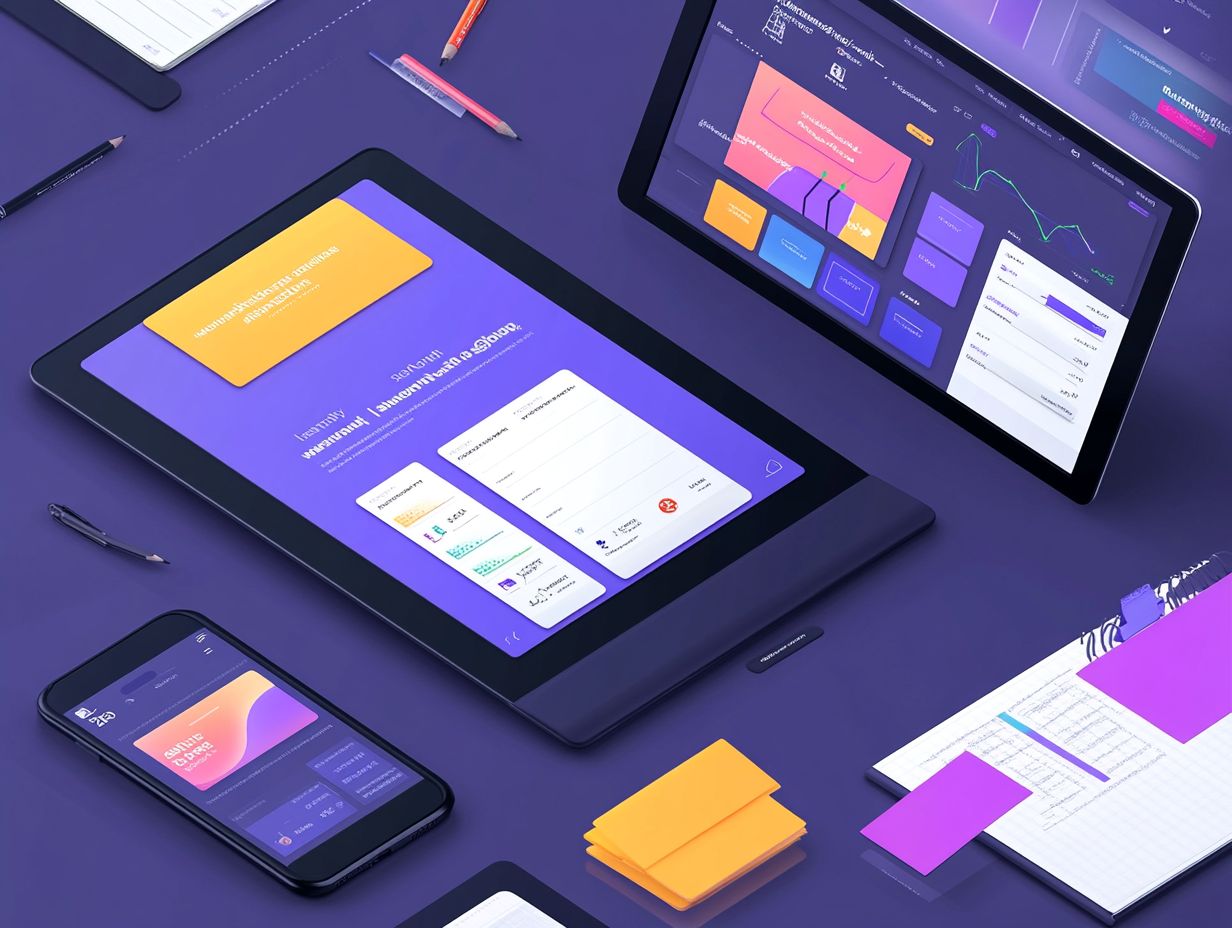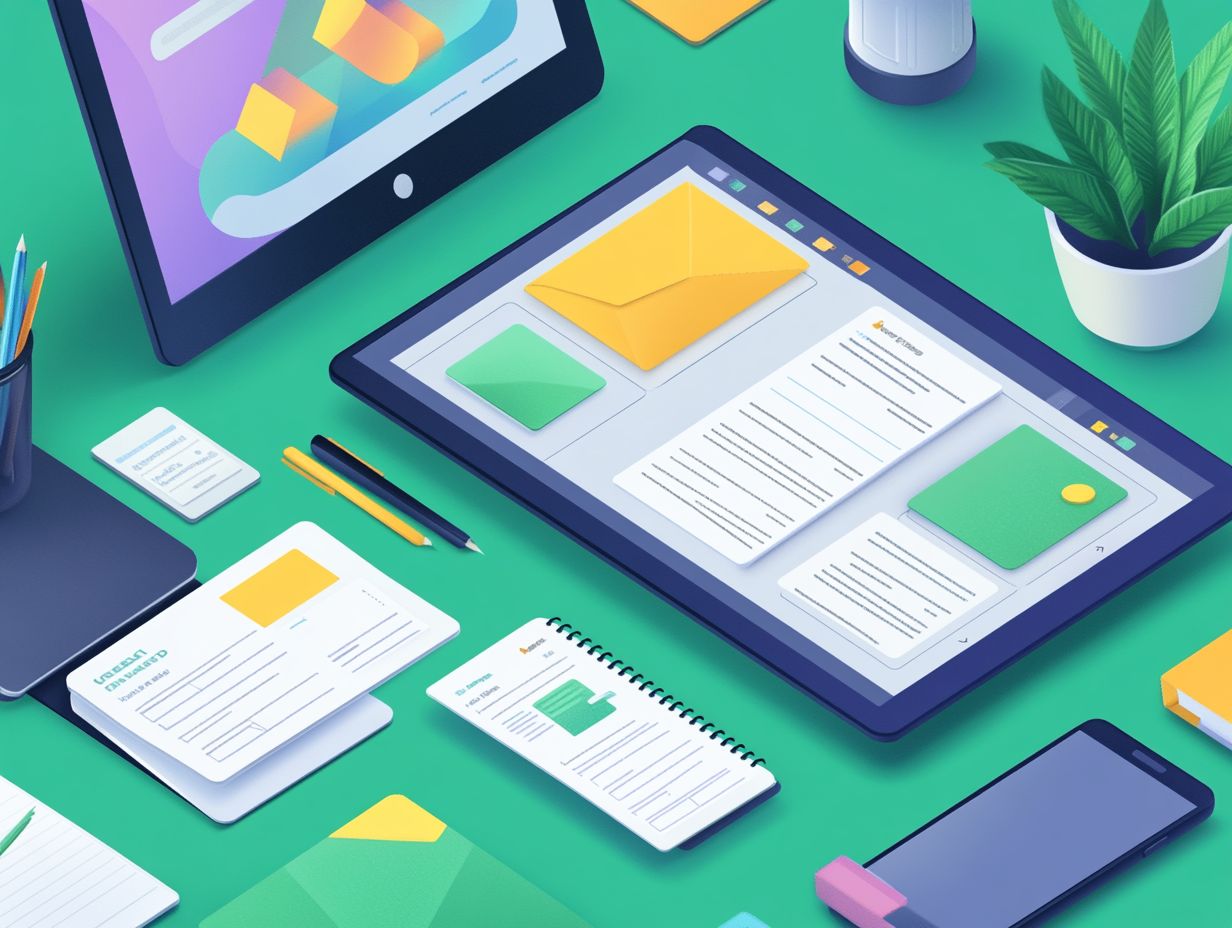In today’s fast-paced environment, effective note-taking has become increasingly essential. With numerous note-taking applications available, selecting the most suitable one can be a daunting task. This article examines the concept of digital notebooks or note-taking applications, emphasizes key features to consider, and provides an overview of the leading options currently available in the market. It includes a comparison of their advantages and disadvantages, offers tips for optimizing their usage, and provides guidance on selecting the most appropriate application to meet individual needs. Prepare to enhance your productivity.
Key Takeaways:
What are Note-Taking Apps?

Note-taking applications are specialized digital tools designed to assist users in capturing, organizing, and retrieving information efficiently. Their primary objective is to streamline the process of information management, facilitating the documentation of ideas, task organization, and enhancement of memory retention.
With features such as the ability to synchronize notes across multiple devices and cross-device access, users can access their information at any time and from any location, thereby ensuring that important data remains readily available. Certain applications prioritize privacy features, including encryption, to safeguard sensitive information, appealing to those who place a premium on security, often referred to as privacy-focused apps.
Notable examples include:
- Joplin, which emphasizes open-source solutions that encourage community-driven enhancements,
- Microsoft OneNote, which integrates seamlessly with other Office tools, making it an advantageous choice for individuals heavily invested in the Microsoft ecosystem, especially with integration capabilities like Slack and Salesforce.
For a broader perspective on the functionalities and features of these tools, consider exploring this comparison of note-taking software on Wikipedia, a respected source that offers comprehensive insights. Regardless of the selected platform, the significant benefits of improved task management, collaboration capabilities, and user-friendly interfaces render these applications essential in today’s fast-paced digital environment.
Key Features to Consider in Note-Taking Apps
When selecting a note-taking application, it is essential to consider key features that enhance the user experience and address specific requirements.
Critical functionalities, such as advanced note-taking capabilities, robust search options, and collaboration tools, are fundamental for fostering productivity and efficiency.
Numerous contemporary applications, such as Notion and Evernote, emphasize user-friendly interfaces and real-time editing capabilities, facilitating seamless collaboration among users across both mobile devices and web platforms, leveraging AI assistance for advanced note-taking. Recognizing these characteristics can significantly influence the effectiveness with which notes are organized and retrieved in both personal and professional environments. As noted in a recent publication in ScienceDirect, digital assistants substantially enhance work productivity, underscoring the importance of integrating AI into these tools.
Must-Have Features for Effective Note-Taking

To ensure effective note-taking, users should prioritize several essential features in their chosen applications, such as note templates and intuitive controls. Key functionalities include intuitive note organization systems that allow for easy categorization and retrieval of notes, as well as robust integration capabilities with other productivity tools and platforms.
Features such as note-sharing options, reminders and alerts, and support for various formats, including Markdown, significantly enhance the user experience and accommodate diverse user preferences. These features are vital for fostering productivity and streamlining workflows.
For instance, a well-designed tagging system, exemplified by applications like Evernote, enables users to group notes based on projects or topics, facilitating the effortless location of critical information when required. Similarly, integration with calendars and task management tools, such as Todoist, allows individuals to synchronize deadlines and meetings directly with their notes, ensuring that they do not miss important appointments.
The capacity to share notes with team members, as offered by platforms like Google Keep and Dropbox Paper, not only promotes collaboration but also enables real-time feedback, significantly improving group workflows. Ultimately, these functional elements play a crucial role in establishing a structured and efficient note-taking process, thereby enhancing information retention and productivity with the help of digital bulletins and interlinked notes.
Top Note-Taking Apps in the Market
The market for note-taking applications is highly saturated, presenting a diverse array of options, each designed with unique features and pricing structures to meet varying user needs, including those who prefer simple note-taking or advanced organizational tools.
Prominent among the leading note-taking applications are ClickUp, Evernote, and Microsoft OneNote, which are recognized for their extensive functionalities, seamless integrations, and comprehensive organizational tools.
These applications not only deliver robust note-taking capabilities but also incorporate advanced features such as real-time editing and collaboration tools, all while maintaining competitive pricing. For instance, a study by ResearchGate suggests various strategies these apps use to stay competitive in the market ( An Analysis of Competition Strategies of Note-taking…).
A thorough evaluation of these applications based on their features and pricing can assist users in selecting the most suitable solution for their personal or professional requirements.
Overview of Features and Pricing

An overview of the features and pricing of popular note-taking applications indicates significant variations that address diverse user needs.
For example, Joplin distinguishes itself with robust Markdown support and the capability to organize notes into notebooks, whereas Google Keep excels in its ability to quickly and effortlessly capture ideas through voice and photo notes.
In the realm of premium options, Notion provides extensive customization and integration with task management tools, making it particularly appealing to project managers and teams. Meanwhile, Evernote enhances the user experience through powerful search capabilities and document scanning features.
The decision between free and premium versions often depends on the user’s specific requirements regarding collaboration, synchronization, and additional productivity-enhancing tools. Ultimately, a thorough evaluation of these factors can assist users in selecting the most appropriate application for their note-taking needs.
Comparison of Popular Note-Taking Apps
A comprehensive analysis of popular note-taking applications demonstrates clear advantages and disadvantages that may impact users’ decisions.
Microsoft OneNote is recognized for its superior organizational features and multimedia support, whereas Google Keep is lauded for its simplicity and ease of access.
Other significant applications include Evernote, which provides robust note synchronization capabilities, and ClickUp, which integrates seamlessly with task management tools.
By evaluating the strengths and weaknesses of each application, including Apple’s iCloud for Apple Notes, users can make informed decisions regarding the option that best suits their needs and preferences.
Pros and Cons of Each Note-Taking App

Each note-taking application presents its own distinct advantages and disadvantages that users must evaluate in order to identify the most suitable option for their requirements.
For example, Evernote is known for its extensive organizational tools; however, it may lack certain customization options when compared to the Joplin app, which is recognized for its strong emphasis on user privacy. In contrast, Microsoft OneNote offers robust integration with other Microsoft products, thereby enhancing productivity for users within that ecosystem. Assessing these strengths and weaknesses can assist users in aligning their preferences with the available features.
Notion distinguishes itself through its versatile workspace that merges note-taking with project management capabilities and task assignments, making it particularly appealing to those who value structured flexibility. However, the steep learning curve associated with Notion may dissuade individuals seeking a more straightforward solution.
Similarly, Bear is acclaimed for its minimalist interface and elegant design, which attracts writers; yet it may fall short in terms of comprehensive cross-platform support.
By thoroughly exploring these various functionalities and user experiences, individuals can make informed decisions that enhance their personal and professional productivity while striking a balance between functionality and ease of use, including distraction-free writing and visual elements.
How to Choose the Right Note-Taking App for You
Selecting the appropriate note-taking application is contingent upon several factors that align with the specific preferences and requirements of each individual user.
It is essential for users to evaluate their needs regarding note organization, task management, collaboration features, and integration capabilities prior to making a decision.
While some users may prioritize a user-friendly interface and seamless synchronization across devices, others may emphasize the importance of multimedia functionalities or advanced note-sharing options.
By thoroughly assessing these factors, users can determine the application that most effectively enhances their productivity and efficiency.
Factors to Consider
Several important factors should guide individuals in selecting the most suitable note-taking application, such as ClickUp, Apple Notes, Google Keep, Joplin app, Evernote, Microsoft OneNote, and Notion, for their personal or professional requirements. User experience is of paramount importance, as a user-friendly interface can facilitate efficient note-taking and organization.
The application’s integration capabilities with other productivity tools, like Slack and Salesforce, can significantly enhance its overall functionality. Additionally, users should consider the app’s support for multimedia elements, such as voice notes and Markdown styles, which can enrich the note-taking experience, particularly in fields such as education and creative workflows.
When evaluating potential applications, multimedia support is especially crucial, as it enables users to incorporate images, audio recordings, and videos into their notes. This feature caters to diverse learning styles and enhances information retention.
Furthermore, robust collaboration features, akin to those found in Quip and Dropbox Paper, allow teams to work simultaneously on projects, enabling the sharing of insights and facilitating real-time brainstorming sessions using brainstorming tools.
Customization options, such as themes and layout preferences, enable users to tailor their environment, thereby making their workflow more comfortable and efficient. Collectively, these elements contribute to a more productive experience, ultimately influencing the selection of a note-taking application that aligns closely with specific needs and preferences.
Tips for Maximizing Note-Taking App Usage
Maximizing the utilization of note-taking applications requires the implementation of best practices that enhance organization and streamline workflows using structured documentation.
Adopting effective methods for note organization, utilizing templates, and incorporating multimedia elements can significantly improve the overall note-taking experience.
Furthermore, integrating AI assistance and utilizing features such as reminders and alerts can aid users in maintaining focus and enhancing productivity across diverse creative workflows.
By adhering to these strategies, users can fully unlock the potential of their selected note-taking application, whether it’s Obsidian, Simplenote, Bear, or another preferred service.
Best Practices for Effective Note-Taking
Implementing best practices for effective note-taking can significantly enhance the quality and usability of notes captured in digital notebooks.
Users may find it advantageous to adopt various techniques, such as the Cornell method, which promotes concise summary writing after capturing detailed information. By establishing interlinked notes, individuals can navigate between related concepts with ease, thereby fostering a deeper understanding and facilitating information retrieval.
Additionally, organizing notes with multimedia elements—such as images, audio clips, or videos—can accommodate different learning styles and provide context that text alone may not convey.
Utilizing Markdown for formatting enables users to create visually appealing and organized notes with headings, bullet points, and hyperlinks, resulting in a more structured document.
These combined approaches not only enhance the overall quality of the notes but also make revision and information recall more efficient, improving data retrieval and contributing to a comprehensive knowledge base.



